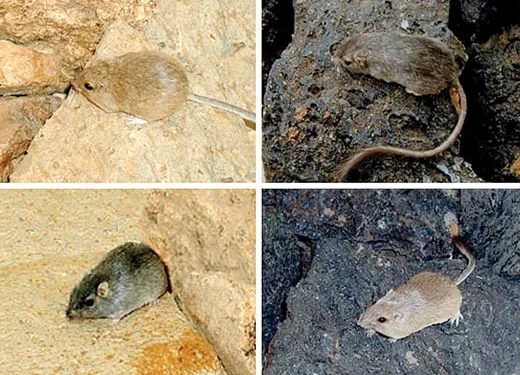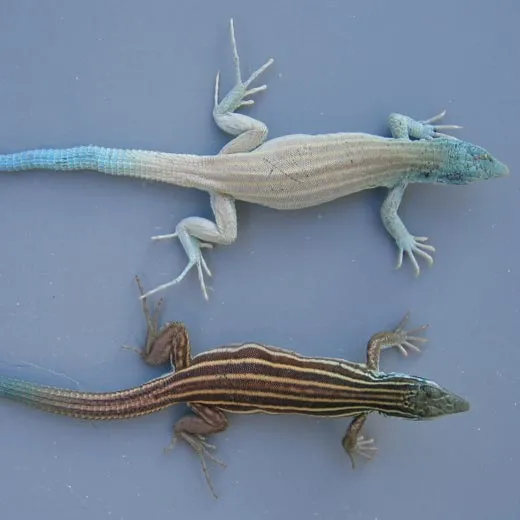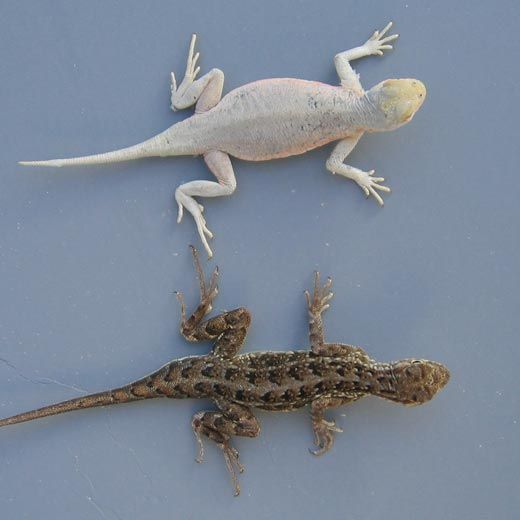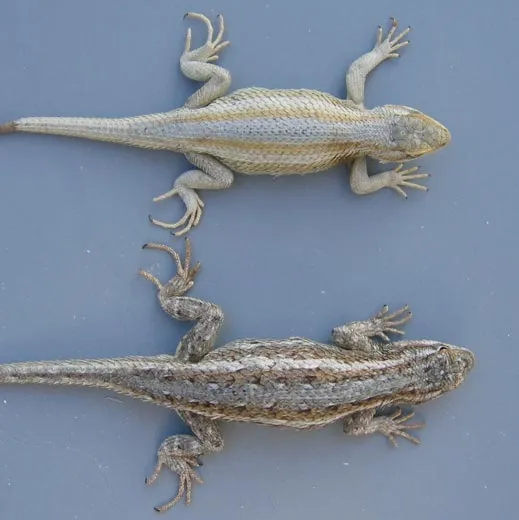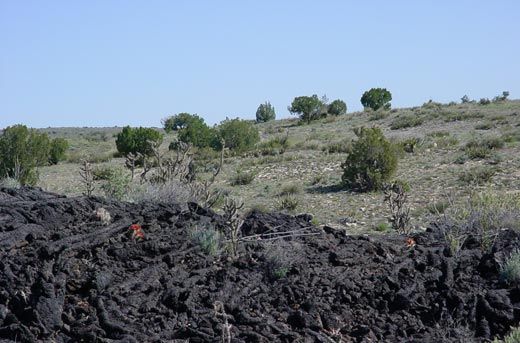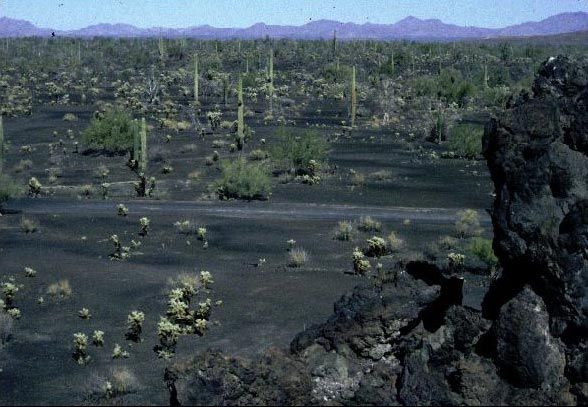Evolution in Black and White
The alternative color forms of some animals are providing new insights into how animals adapt and evolve
/https://tf-cmsv2-smithsonianmag-media.s3.amazonaws.com/filer/spotted-and-black-jaguars-631.jpg)
Shortly after he completed his second term as president in 1909, Teddy Roosevelt took a year-long hunting safari in Africa under the auspices of the Smithsonian Institution. Many of Roosevelt’s trophies wound up as exhibits in the Smithsonian and the American Museum of Natural History in New York. Roosevelt’s safari experiences, regaled in his book African Game Trails (1910) gave him strong opinions about how animals blended, or did not blend, with their surroundings:
“Black and white are normally the most conspicuous colors in nature (and yet are borne by numerous creatures who have succeeded well in the struggle for life); but almost any tint ... harmonizes fairly well with at least some landscapes, and in but a few instances among the larger mammals, and in almost none among those frequenting the open plains, is there the slightest reason for supposing that the creature gains any benefit whatever from what is loosely called its ‘protective coloration.’”
Roosevelt’s scoffed at notions of the protective value of coloration for two reasons. First, the horse-mounted hunter extraordinaire had little difficulty spotting, stalking and bagging big game; his hunting party shot more than 500 mammals. Clearly animals’ colors did not protect them from him. And second, while at the time the fact of evolution was widely accepted by scientists (and Roosevelt), Darwin’s explanation of the primary role of natural selection as the mechanism of evolution was not. Natural selection had fallen out of favor, in particular over the matter of animal coloration. Many naturalists in the 1890s had criticized Darwinian explanations of coloration as wholly lacking evidence, and offered other explanations. For instance, some suggested that coloration was directly caused by external factors such as climate, light or diet.
These alternative ideas were soon quashed by the emergence of the science of genetics and the demonstration through breeding experiments (such as those originally conducted by Gregor Mendel) that coloration is an inherited property of plants and animals. But until the past few years, we did not know how genes determine animal coloration or how variation in genes affect variation in coloration in nature. New understanding of how animal colors are made, particularly simple patterns of black and white, and field studies of the benefits and drawbacks of color schemes in different habitats, are now providing some of the best examples of how natural selection and evolution work.
One of the most widespread phenomena in the animal kingdom is the occurrence of darkly pigmented varieties within species. All sorts of moths, beetles, butterflies, snakes, lizards and birds have forms that are all or mostly black. Perhaps most familiar are the dark big cats, such as the black leopard and black jaguar. These beautiful animals are often displayed in zoos as curiosities, but they also occur in the wild in significant numbers.
All of these so-called “melanic” forms result from increased production of the pigment melanin in the skin, fur, scales or feathers. Melanic pigmentation can serve many roles. Melanin protects us and other animals from the ultraviolet rays of the sun; it can help animals in colder climates or higher altitudes warm their bodies more quickly, and, contrary to Roosevelt’s skepticism about protective coloration, black pigment does conceal some animals from predators.
In the deserts of the southwestern United States, for instance, there are outcrops of very dark rocks that were produced by lava flows over the past two million years. Among these rocks lives the rock pocket mouse, which occurs in dark black and a light, sandy color. Naturalists in the 1930s observed that mice found on the lava rocks were typically melanic, while those on the surrounding sand-colored granite rocks were usually light-colored. This color-matching between fur color and habitat background appears to be an adaptation against predators, particularly owls. Mice that are color-matched to their surroundings have a survival advantage over mismatched mice in each of the two habitats.
Recently, Michael Nachman and his collaborators at the University of Arizona have undertaken detailed field and genetic studies of rock pocket mice. They have found that the mice interbreed with mice from other habitats and migrate between rock types. The mice are clearly one species, not two. So what makes fur black or light? Just a few differences in the code of a single gene. This simple basis of inheritance means that the origin of black mice from light-colored parents happened in just one or a very small number of mutational steps. But for mice invading the previously alien habitat of black lava rocks, those small genetic steps were a giant leap in terms of evolution. Nachman and Hopi Hoekstra (now at Harvard University) estimated that dark mice have about a 60 percent or greater survival advantage over light mice on the dark lava rocks. In other words, fur color in this species is clearly under very strong natural selection.
The gene involved in the origin of melanism in rock pocket mice is called melanocortin receptor 1, or MC1R or short. That is not a very interesting nugget of information, until I tell you that the melanic forms of jaguars, snow geese, arctic fox, fairy wrens, banaquits, golden lion tamarins, arctic skua, two kinds of lizards, and of domestic cows, sheep and chickens are caused by mutations in this very same gene. In some species, precisely the same mutations have occurred independently in the origin of their dark forms. These discoveries reveal that the evolution of melanism is not some incredibly rare accident, but a common, repeatable process. Evolution can and does repeat itself.
Melanism is not only a matter of concealment. The lesser snow goose also occurs in two forms, a white and a melanic “blue” form. In this species, the mating preference of individuals follows the color scheme of their parents. Apparently, young birds learn their parents' color and choose mates along family lines–birds from blue families prefer blue mates and birds from white families prefer white mates. Mating preferences among arctic skuas have an additional twist, in that females generally prefer darker males. Both of these bird species are evolving under sexual selection, a process also first described by Darwin, in which traits that are advantageous in the mating game are favored. Because sexual selection has such a strong effect on mating success, it is a very strong form of selection in nature.
Another common form of animal coloration is the lack of pigmentation–or albinism. This condition is frequently observed in natural populations of cave-dwelling animals, including fish, crayfish, insects, spiders and other species. The common occurrence of albinism in cave animals is thought to represent the flip side of evolution under natural selection. That is, with little or no light, natural or sexual selection on pigment color and pattern is relaxed. Mutations that abolish pigmentation, and that would generally be harmful to animals in other habitats, are tolerated in the darkness of these caves.
Albinism, too, appears to have a simple genetic basis that makes it “easy” to evolve. Recently, Meredith Protas and Cliff Tabin at Harvard Medical School, Bill Jeffery at the University of Maryland, and their collaborators pinpointed the genetic basis of albinism in the Mexican blind cavefish. These albino fish are found in about 30 caves in the Sierra de El Abra region in northeastern Mexico. Each population is derived from a pigmented, fully sighted surface- or river-dwelling form. The researchers have investigated the genetic basis of albinism in populations from the Pachón and Molino caves and found that albinism in each population was caused by mutations in the same pigmentation gene, but different specific mutations in each case. Here again, in these fish, evolution has repeated itself twice in the origin of the same trait. Furthermore, the specific gene mutated in these fish is also the same gene responsible for albinism in humans, pigs, mice and other fish species.
The natural histories of the rock pocket mice and cavefish vividly demonstrate how animals have adapted to new surroundings; no matter how alien those habitats once were to their ancestors. These obscure animals have also provided the concrete links between specific genes, natural selection and evolution in the wild that have long been sought by biologists. While not as majestic as the game animals of the African savanna, these animals illustrate larger lessons that would have been appreciated by Roosevelt, and perhaps even warranted their own, albeit small, trophy case for displaying the continuing progress in understanding how evolution works.
Author Bio:
Sean B. Carroll is an evolutionary biologist at the University of Wisconsin. His new book, Remarkable Creatures: Epic Adventures in the Search for the Origins of Species (Houghton Mifflin Harcourt), chronicles the experiences and discoveries of intrepid naturalists who developed and advanced the theory of evolution.
